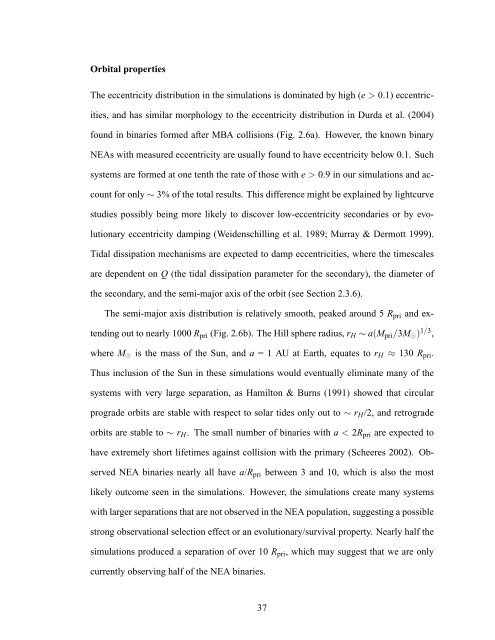Forming Binary Near-Earth Asteroids From Tidal Disruptions
Forming Binary Near-Earth Asteroids From Tidal Disruptions
Forming Binary Near-Earth Asteroids From Tidal Disruptions
You also want an ePaper? Increase the reach of your titles
YUMPU automatically turns print PDFs into web optimized ePapers that Google loves.
Orbital propertiesThe eccentricity distribution in the simulations is dominated by high (e > 0.1) eccentricities,and has similar morphology to the eccentricity distribution in Durda et al. (2004)found in binaries formed after MBA collisions (Fig. 2.6a). However, the known binaryNEAs with measured eccentricity are usually found to have eccentricity below 0.1. Suchsystems are formed at one tenth the rate of those with e > 0.9 in our simulations and accountfor only ∼ 3% of the total results. This difference might be explained by lightcurvestudies possibly being more likely to discover low-eccentricity secondaries or by evolutionaryeccentricity damping (Weidenschilling et al. 1989; Murray & Dermott 1999).<strong>Tidal</strong> dissipation mechanisms are expected to damp eccentricities, where the timescalesare dependent on Q (the tidal dissipation parameter for the secondary), the diameter ofthe secondary, and the semi-major axis of the orbit (see Section 2.3.6).The semi-major axis distribution is relatively smooth, peaked around 5 R pri and extendingout to nearly 1000 R pri (Fig. 2.6b). The Hill sphere radius, r H ∼ a(M pri /3M ⊙ ) 1/3 ,where M ⊙ is the mass of the Sun, and a = 1 AU at <strong>Earth</strong>, equates to r H ≈ 130 R pri .Thus inclusion of the Sun in these simulations would eventually eliminate many of thesystems with very large separation, as Hamilton & Burns (1991) showed that circularprograde orbits are stable with respect to solar tides only out to ∼ r H /2, and retrogradeorbits are stable to ∼ r H . The small number of binaries with a < 2R pri are expected tohave extremely short lifetimes against collision with the primary (Scheeres 2002). ObservedNEA binaries nearly all have a/R pri between 3 and 10, which is also the mostlikely outcome seen in the simulations. However, the simulations create many systemswith larger separations that are not observed in the NEA population, suggesting a possiblestrong observational selection effect or an evolutionary/survival property. <strong>Near</strong>ly half thesimulations produced a separation of over 10 R pri , which may suggest that we are onlycurrently observing half of the NEA binaries.37












